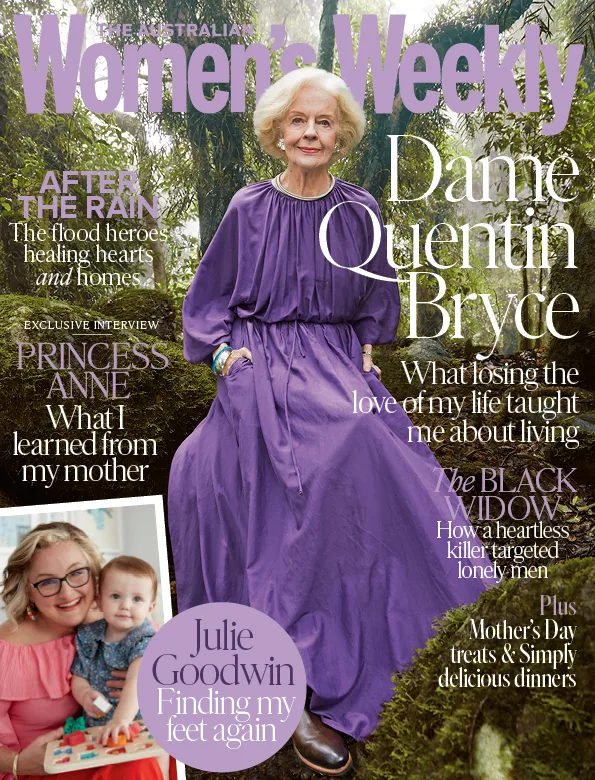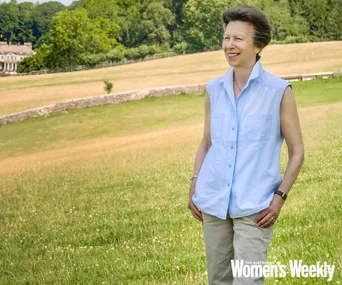The Princess Royal is famously pegged as the British monarchy’s hardest working royal because of the hundreds of engagements she carries out each year, so it came as no surprise that Her Royal Highness was the first member of the House of Windsor to fly out to Australian shores when border restrictions lifted.
True to form, the three-day tour, followed by a hop over to Papua New Guinea to mark the Platinum Jubilee, was carried out at a frenetic pace. But with her husband, Vice Admiral Sir Tim Laurence, by her side, the Queen’s only daughter was in her element reconnecting with a part of the world she tells me she has always loved.
The Princess was ostensibly here for a working visit as patron of the Royal Agricultural Society of the Commonwealth (RASC) for its bicentenary. To mark the occasion the royal couple had been invited to the opening ceremony of the Sydney Royal Easter Show, spending the whole day at the showgrounds.

Princess Annd and husband Sir Tim Laurence drive into the opening ceremony surrounded by considerable military pomp in the historic 150-year-old calèche.
(Image: Getty)Palace aides then tailored a bespoke program of engagements to touch on other key areas of interest for the Princess, especially talking to members of frontline services for fire and floods.
“My husband’s brother lives at Lismore. Fortunately, up the hill. We’ve been kept in touch with the flooding,” she explains in my exclusive interview in England in advance of the tour. “I have to say it’s one of the things about the Sydney Show which I think brings together so much of the impact of what’s been happening, the extreme of the fires you’ve suffered and the floods. Sir Tim and I are working farmers so very much appreciate the opportunity to visit the Sydney Show.”
Princess Anne first visited back in 1970 and today she and Sir Tim arrived at the opening ceremony in the same historic horse-drawn calèche that 52 years earlier she had climbed into with her parents, the Queen and the Duke of Edinburgh, and elder brother Prince Charles. That trip was the young Princess’s first major overseas tour and also the first time the now ubiquitous ‘walkabout’ had been tested in Australia.
This was the groundbreaking new way the royal family connected with the public, no longer standing on ceremony, but heading out into the crowds to meet people face-to-face. While it is now considered a cornerstone of royal tours, for the shy 19-year-old such encounters proved intimidating. “To be faced with a wall of strange faces, which may look very friendly at the time, but where do you start the conversation? That is quite a daunting prospect,” she confesses, smiling at the memory.
“We started the trip further south, so the introduction to the walkabout was in Melbourne. Sydney was a lot more buzzy, and of course, in a way the Easter Show is exactly the right place to go when you first go to Australia because there is everything that is Australian there and people from all over the country. It is a huge introduction to Australia; a really good place to start.”
Despite the anxiety of fronting up to crowds – which were huge – the Princess’s passion for the Show was ignited that day. “I was really delighted when my father asked me to succeed him as Patron of the RASC,” she said on this visit and her fervour was clear to see.

Princess Anne laughs with locals after handing out winners’ ribbons to some of the prize cattle.
(Image: Getty)The Princess insisted on staying on foot in the showgrounds rather than being chauffeured in a buggy, so she could chat to as many people as possible. As she strode through the crowds she was greeted by excited faces and gasps of delight. And when she was called on to hand out ribbons for prize-winning calves and rosettes to youngsters involved in Riding for the Disabled, of which she is also the patron, she eagerly shared her knowledge of farming and rural life.
Watching from the sidelines, it was obvious that the royal has an army of fans in Australia. Indeed, as soon as her attendance was announced some weeks before the visit, ticket sales soared. Usually it is the following Easter weekend that is most popular, but the star power of the Princess Royal pushed April 9 to the top of the show’s sales’ charts, with 55,000 through the gates that day.
As a member of the royal family, crowds are an occupational hazard, but I wonder if the Princess still found them as confronting today. “It’s always interesting – because you just find people with stories to tell. So yes, I’m less daunted but maybe approach it slightly differently. Of course, weirdly, technology rather gets in the way now because whereas in those days [there was] the odd camera – now if you’re not careful it’s a wall of phones and you can’t actually see anybody,” she laughs.
WATCH: Princess Anne appears for a TV interview in 1980. Story continues after video.
Back in 1970 Princess Anne watched and learned from her parents, a necessary process of osmosis that formed her initiation into a life of service. “We’d been away for a while by then so we were getting into the swing of it. I think there is no way they [the Queen and the Duke] could have prepared you for just how tiring it gets. Suddenly you find that you’ve woken up in the middle of the night having a nightmare that you’re standing in the middle of a reception and you can’t speak. That creeps up on you and I think you just learn to pace yourself. I can now sleep in any form of transport, which does help!”
Choosing the right wardrobe was another learning curve. On that first trip the Princess’s hat was caught in a gust of wind and reporters famously heard her utter “bloody wind”, a comment which fuelled the tabloids. “Milliners do things which make perfect sense when you’re standing still inside; it makes slightly less sense when you’re outside in a draught, especially when it’s blowing from behind you, but that’s experience, as they say. These things you learn how to deal with.”
Another sartorial lesson adopted from her mother was putting weights in skirt hems. “For some materials that was an absolute necessity. It’s fine if you want to wear light clothes but airports, always breezy, never a good idea, so you find some way of dealing with that. It’s a very old-fashioned habit. You wouldn’t find it much now unless you actually asked or had things specifically made.”
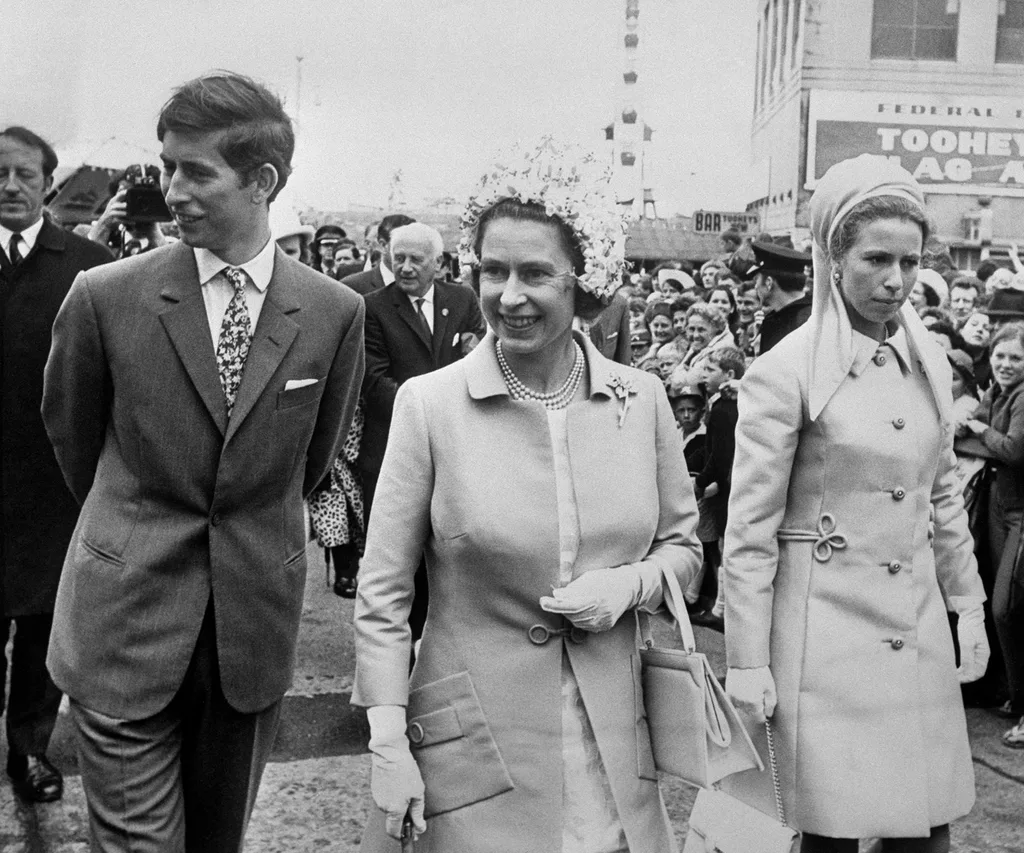
Queen Elizabeth II with Princess Anne and Prince Charles at the Royal Easter Show in Sydney during the 1970 Royal Tour of Australasia.
(Image: Getty)Prince Charles had been to school in Australia at Geelong’s Timbertop and was already a fan of our outdoor lifestyle, ocean swimming and surfing. “We did go to his school in Geelong and I had a chance to meet some of his friends,” the Princess recalls. “I rather envied him that opportunity, I have to say. I could have done with seeing a bit more [of Australia].”
Nevertheless, on that first trip the Princess did manage to fit in her own private time out. “I was race riding at the time and I actually went out and rode for three days. From my perspective it was trying to keep fit because I was coming back to riding at home so I didn’t really want to spend a week sitting on my backside doing nothing. I rode a horse that had been in the Australian [1968 Mexico Olympics] team in Centennial Park in Sydney. That was, in retrospect, one of the bravest things I’ve ever done but he was a lovely horse,” she tells me.
Why brave? “Because I jumped some of the fences there,” she beams.
Princess Anne is adamant that agricultural shows like the Easter Show still have relevance. “The great thing about the Sydney show is since it first began it’s been bringing people [together] learning about Australia and how to be more successful in farming to build on its strengths in that time,” she explains. “The emphasis will have shifted [and] we certainly found in this country that agricultural shows have made a bit of a comeback because they’ve recognised that it is not so much about the farming community that needs to be stuck together, it’s introducing and making sure people understand farming who no longer have that automatic connection.
“Two hundred years ago everybody would have understood perfectly what the shows are trying to do, but that would have been a market, somewhere where you could promote how good you were in front of other farmers. Now, it’s more a question of educating populations as to the issues and challenges that farming faces.”
On the second day of the tour the Princess was eager to meet with Rural Fire Service volunteers and pay her respects to the families of two firefighters who had tragically lost their lives in the 2019 bushfires. It was emotional for Errol O’Dwyer who held his son Andrew’s framed photo as he talked to the Princess. Standing next to him was Andrew’s little girl, Charlotte, who was just 19 months old when her father died aged 35. In her speech the Princess highlighted the impact of loss on a community and the risks volunteers take on. She had no notes and spoke from the heart.
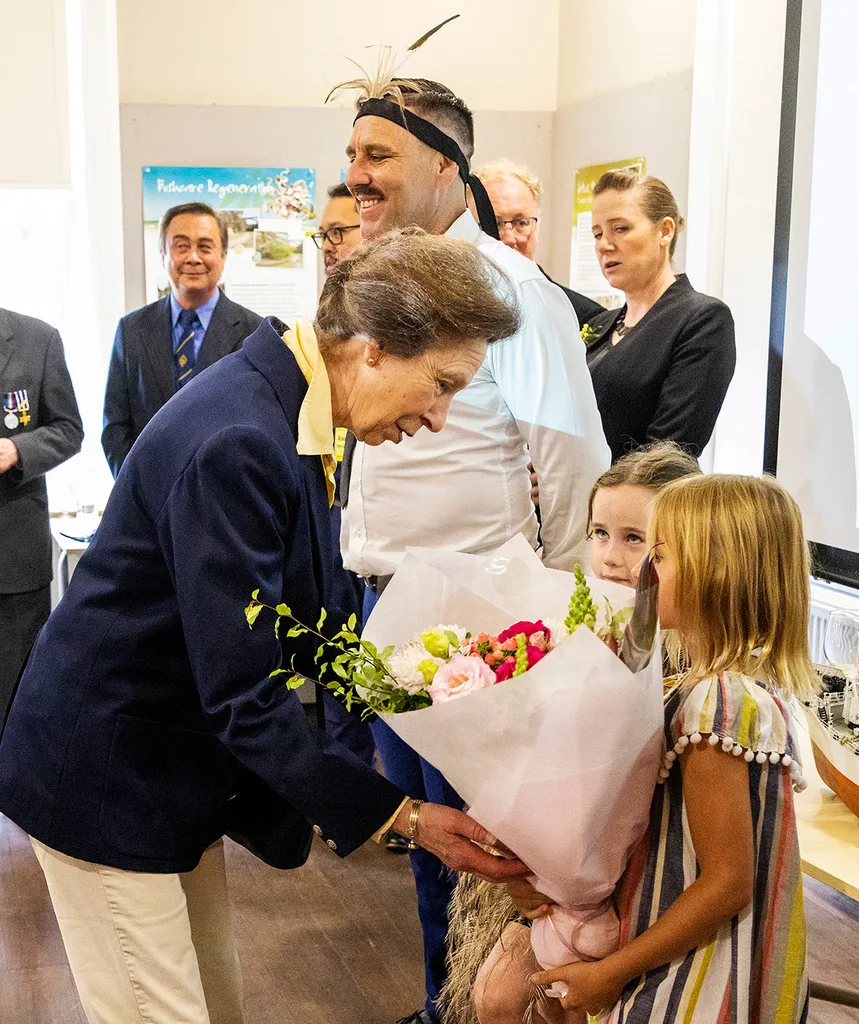
Her Royal Highness accepts flowers during a visit to the Sea Heritage Foundation in Waverton in Sydney, Australia.
(Image: Getty)Afterwards she visited the Sea Heritage Foundation’s MV Cape Don, a lighthouse tender vessel under restoration, where her brother’s charity, Prince’s Trust Australia, is partnering with an initiative to train First Nations’ youth in the maritime industry. The Princess and former naval officer Sir Tim were fascinated by the ship and the project. “I think there’s the scope for making use of the history to inspire the next generations, because we’re all short of maritime workers,” she comments.
In a few weeks the Princess Royal will be joining the celebrations for Her Majesty’s Platinum Jubilee and inevitably our conversation turns to her mother’s legacy. “It’s a very difficult thing to put your finger on. I doubt if there’s a single description that would fit the bill,” she muses. “There is an element of constancy here in terms of attitude to service and recognition of service, the values that individuals bring … I think she’s been able to support that and bring those people to the fore in a way that is so important.
“[Likewise] The Queen and I had a discussion the other day about the difference between fashion and style and I think maybe that’s relevant in the sense that she didn’t do fashion but she certainly does style, and style tends to last longer. You have an individual style and it’s a quality which has a long-term value.”
WATCH: Princess Anne helps her mother, The Queen, on a Zoom call. Story continues after video.
And while the longevity of Her Majesty’s reign is historic, her sheer volume of knowledge is also quite mind-blowing. “Yes, when you tot up the number of leaders of countries and her own prime ministers, that’s a quite extraordinary perspective.
“Her memories and understanding of each of those was they reach that point and the impact they can make – but equally having the ability to recognise that every individual could do it slightly differently. That may be part of the value. We’re not all the same.”
The Princess’s father was her mother’s “strength and stay” and now he’s gone, his contribution is fully recognised. “Unwavering support is probably the best way of describing it,” his daughter notes. “I think he also understood the things he was better staying out of – although it was quite difficult in the early days – but there were also distinct areas where he could help and did. His input and perspective and the fact that his travels took him to a slightly different area of the country and internationally could have a real impact. I think he learned how to distinguish when those moments were.” The Princess concedes that her father would have had a tough initiation. “I’m sure it wasn’t very easy to begin with because there was no such thing as a role then. He had to invent that one.”
When I ask what lessons she has learned from her mother, Princess Anne returns to the idea of style. “Maybe it is that style in the long term and the way you do things, remaining constant. I think it’s the way you treat people, with respect for individuals. When you’ve been around for long enough and people keep changing at the top of your organisations, if you’ve had a good relationship, a bit like prime ministers, you need to accept the next one because that isn’t necessarily the only way of doing anything. There are moments when you think, ‘are you sure that’s what you ought to be doing?’, but you have to stand back and let them get on.”
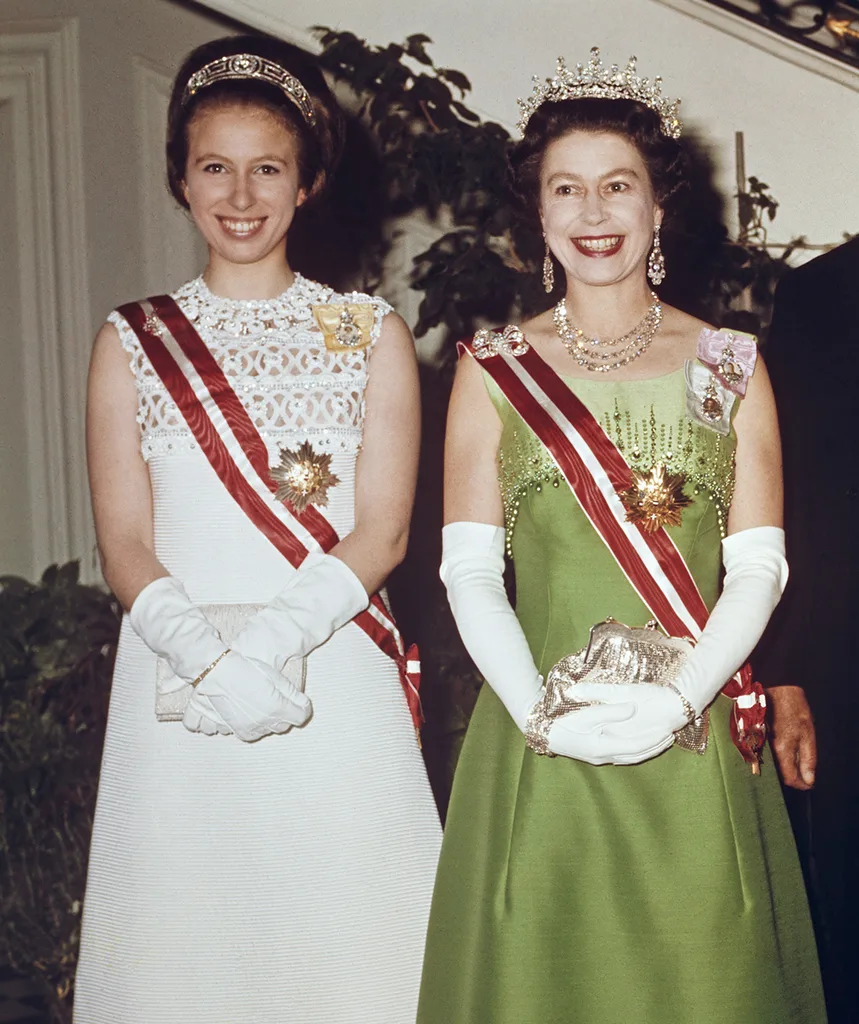
The Princess Royal says she learned a great deal about style from her mother, The Queen.
(Image: Getty)When the Queen was crowned, her daughter was second in line to the throne; today she’s 17th behind her younger brothers. It’s a gender penalty that is no longer applied and many feel it should be fixed retrospectively to reflect The Princess Royal’s unfailing sense of duty and service that, at 71, is as strong as ever.
But Princess Anne says she feels her gender has never been an obstacle. “I have been treated as an honorary man for a lot of my life. I did take part in a sport which didn’t have any gender balance. It was open to both, end of story. So, I had the benefit of being treated equally … although oddly enough when I first went to Australia I found a difference, the men went down one end of the room and the women went up the other. I didn’t think that was entirely appropriate.”
Now, Princess Anne thinks Australia has moved on and it’s a place she never tires of visiting. “I think Australia remains as one of the most attractive places to go to, for whatever reason – work or leisure.”
You can read this story and many others in the May issue of The Australian Women’s Weekly – on sale now
